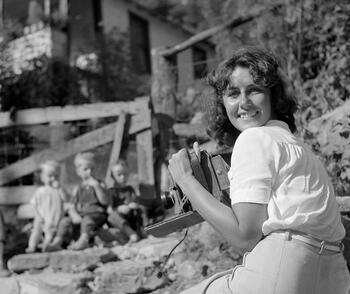Grinding and whetting away across the room
By Rob Carrigan, robcarrigan1@gmail.com
Nearly two thirds of the hardware business back then was knowing where things were in the store. Back on the narrow counter above the pipe fittings and grade 5 machine bolts at Taylor Hardware, a well-worn oil stone with a fine and a finer side rested on the top the counter, in an old metal case with an form-fitted oil sponge under it. Thin in the middle, (a little more so on the finer side,) the foot-long stone had been whetted down for nearly a century, and was a gathering place of sorts.
Sometimes W.T. (Dopey) Butler would come in early in the morning, often on a Monday, and after collecting several items he knew by location, he would spend a few precious minutes sharpening his knife – and his wit in a conversation with owner Merton Taylor, who, by this time was working on a hardware order at the microfiche reader across the room. Dopey was a busy man and could not waste his entire day embroiled in a theoretical discussion with Merton, but maybe, just a little time on Monday morning, when the owner was too busy to kill the whole morning.
Locally, "Dopey" Butler was very well known, and more than a few locals had a vivid recall of watching the long-time contractor building a pond nearby, or his measured consideration serving on many local water boards and commissions. And more than a few noted his fascinating command of machines one of the reasons for his choosing hydrology. I was told (by his son Bill) that he acquired the name "Dopey" at young age, when he starred as one of Seven Dwarfs in a grade school play. Like a lot of things in respect to reputation in a small town, the name stuck forever afterward.
One of 12 children raised on the family farm on Granath Mesa above Dolores, the Butler family was legendary in Dolores. Five brothers served in WW II. Paul Butler, the oldest, served in the Army from 1941 to 1945. Robert
Butler, better known by his middle name, Maurice, was a radar man in the
Navy from 1944 to 1946. Wilbur “Dopey” Butler also served in the Navy
as a radio man. David “Bud” Butler, who was not quite 18 when he joined
the Army, served in the 309th Regiment of the 78th Infantry Division.
Oddly enough, "Dopey" Butler didn't worry too much about recognition. I do remember an instance where he rushed in, grabbed the log-chain with the shop key attached, and self-located a V-Belt part he needed in the old International Harvester Dealership shop behind the main store. He came running back in, called out a part number, that was written down in his book behind the nail counter, and scrawled his traditional big X across the page in front of some newcomer to town. Not knowing what had transpired, the newcomer lamented the sad state of such lack of education in this day and age. I recall Trucking Company owner Pat Burns (who was also in there at the same time) nearly laughing himself silly. "You know, that man is probably the smartest man in Montezuma County," Pat said.
Anyway, "Dopey" seemed to enjoy sparring mentally with Merton, especially when he did not have time to do it too long. I can still remember his tall form leaning awkwardly against the angled counter in his work boots and heavy Artic Cat coat, grinding and whetting away across the room, and flipping over the oil stone, and trying to get a suppositional edge on Merton Taylor, and his own Old Timer knife, at the same time. As I mentioned earlier: Nearly two thirds of the hardware business back then was knowing where things were in the store.
###









































